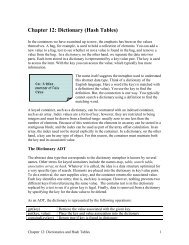Project Report Guidelines - Classes
Project Report Guidelines - Classes
Project Report Guidelines - Classes
You also want an ePaper? Increase the reach of your titles
YUMPU automatically turns print PDFs into web optimized ePapers that Google loves.
ME 383 FINAL PROJECT REPORT:<br />
ASSIGNMENT GUIDELINES<br />
DOCUMENT SPECS<br />
<strong>Report</strong> Purpose:<br />
<strong>Report</strong> on your failure analysis project and results, discuss reliability issues and suggest product<br />
improvements.<br />
Target Audience:<br />
Upper management of an imaginary company that is interested in understanding and analyzing the failure<br />
potential and reliability of the product you have selected, to determine whether they should invest in it<br />
further.<br />
Format:<br />
Times-Roman, 12 pt (or equivalent font size in another audience-appropriate font), single line spacing, 1”<br />
margins, left-justified.<br />
Length:<br />
10 pages, not including the appendices with the detailed analysis results and drawings.<br />
DOCUMENT SECTIONS<br />
Front matter:<br />
• Title page (includes report title, team number and members, course number and term, report submission<br />
date, and Professor’s name)<br />
• Table of Contents (include titled appendixes )<br />
Executive Summary (should be written last):<br />
• Designed to be read independently of report, so should not refer to figures, tables, or other visuals in the<br />
body of the report or appendices. Should avoid unfamiliar terminology; and abbreviations and acronyms<br />
should be spelled out.<br />
• Content: States purpose and scope of investigation & gives major findings, conclusions, and<br />
recommendations. Only briefly describes the procedures and methodologies on which the findings,<br />
conclusions and recommendations are based.<br />
• Organization: May either follow report organization or highlight findings, conclusions, and<br />
recommendations first, then provide procedures/methodology.<br />
• Length: Proportional to report length (typically 5–10% of report length). For this report, 1 page maximum.<br />
• Layout: Attractive and easily readable, single-column format. Must include table or figure showing<br />
results, and figure showing product that was analyzed.<br />
<strong>Project</strong> Introduction and Problem Description:<br />
• Explains project purpose and lays out report structure (why was the project done; how is it presented in this<br />
document?)<br />
• Introduces and describes system studied (what it is, what it does, how it works?)<br />
• Discusses functional decomposition and customer and (as appropriate) engineering requirements. May<br />
include full functional decomposition in the Appendix.<br />
• Demonstrates clear understanding of project (and project/report purpose) by group members.<br />
Force Characterization and Analysis<br />
• A summary and in-depth discussion of the force analysis, including ALL assumptions on loading.<br />
• References free body diagrams and force analysis details, which should be included in the Appendix.<br />
Static and Dynamic Failure Analysis:<br />
• Presents results of static and dynamic analyses, with ALL assumptions listed and justified.
• Discusses the values calculated for safety factors, whether they make sense or not, provides justification for the<br />
values that do not make sense, tracing them back to the assumptions. Provides future direction to compute<br />
correct safety factors.<br />
• Discusses reliability and risk aspects: why was the system designed to the factor(s) of safety you’ve<br />
calculated?<br />
• References detailed engineering calculations located in the Appendix. These calculations are neatly<br />
formatted and explained, including all assumptions and equations, and free from technical errors.<br />
Conclusions and Recommendations:<br />
• Summarizes your system, analysis results, and system’s failure potential<br />
• Addresses the validity of every assumption based on results.<br />
• Offers recommendations on (a) how the device could be better designed and (b) whether the company<br />
should invest in this product further.<br />
Works Cited<br />
• Includes all sources referenced in document, correctly formatted per APA (or other?) style<br />
Appendixes<br />
• Functional Decomposition and Engineering Requirements.<br />
• Free Body Diagrams (number as Figures B1, B2, B3, etc., include captions identifying captions (e.g.,<br />
“Figure B1. Handle diagram), and force analysis calculations.<br />
• C: Static and fatigue failure analysis calculations (title and number individual calculations as C1, C2, C3,<br />
etc (e.g., “C1: Static Stress on Spring”). One set of calculations per page.<br />
GLOBAL DOCUMENT QUALITIES:<br />
Clarity and Concision<br />
• Writing is straightforward and free of padding, with no unnecessary repetition of information.<br />
• Main ideas stand out and claims are sufficiently supported with relevant details and references.<br />
Organization<br />
• Text contains effective sequencing and paragraph breaks, and the writing is easy to follow.<br />
• Writing includes smooth, effective transitions between sections, paragraphs, sentences, and ideas.<br />
• Introductory and sign-posting text is used to orient the reader.<br />
• Details fit where placed.<br />
Conventions of Usage and Style<br />
• Writing demonstrates excellent control of standard writing conventions (punctuation, spelling,<br />
capitalization, grammar) and uses them effectively to enhance communication.<br />
• Tone and vocabulary are appropriate for target audience<br />
Citation Practices<br />
Supporting visuals<br />
• Figures and tables (both within document body and in appendixes) are sequentially numbered (Fig. 1, Table<br />
1, Fig A1, etc.) and referenced in the body of the report, prior to appearance in text.<br />
• Figures and tables include explanatory captions. If borrowed from another source, source should be cited in<br />
caption.<br />
Information drawn from other sources:<br />
• Borrowed information is properly cited in text (using APA format)<br />
• All cited sources are included in bibliography in APA format

















